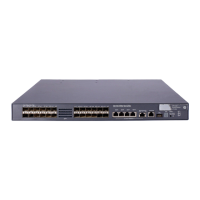187
To do... Use the command... Remarks
4. Assign the port to CVLANs
and SVLANs
port trunk permit vlan { vlan-id-list
| all }
Required.
By default, a trunk port is in only
VLAN 1.
5. Enable customer-side QinQ
qinq enable downlink
Required.
By default, customer-side QinQ is
disabled on all ports.
6. Apply the uplink policy to the
incoming traffic
qos apply policy policy-name
inbound
Required.
Before applying a QoS policy to the customer-side port, enable customer-side QinQ on the port. Before
disabling customer-side QinQ on the customer-side port, remove the QoS policy from the port first.
Configuring the network-side port
To configure the network-side port:
To do... Use the command... Remarks
1. Enter system view
system-view —
2. Enter Layer 2 Ethernet
interface view
interface interface-type interface-
number
—
3. Configure the port as a trunk
port
port link-type trunk
Required.
The default link type of an
Ethernet port is access.
4. Assign the port to SVLANs
port trunk permit vlan { vlan-id-list
| all }
Required.
By default, a trunk port is in only
VLAN 1.
5. Configure the port as a DHCP
snooping trusted port
dhcp-snooping trust
Required.
By default, all ports are DHCP
snooping untrusted ports.
6. Configure the port as an ARP
trusted port
arp detection trust
Required.
By default, all ports are ARP
untrusted ports.
7. Enable network-side QinQ
qinq enable uplink
Required.
By default, network-side QinQ is
disabled on all ports.
Configuring two-to-two VLAN mapping
Perform two-to-two VLAN mapping on an edge device that connects two SP networks, for example, on PE
3 in Figure 59. T
wo-to-two VLAN mapping enables two remote sites in different VLANs to communicate at
Layer 2 across two service provider networks that use different VLAN assignment schemes.
For the ease of description, the VLAN tags of the double-tagged frames that arrive at the customer-side
port are called foreign CVLANs and SVLANs, and the VLAN tags marked by the edge device are called
local CVLANs and SVLANs.
Perform these tasks to configure two-to-two VLAN mapping:

